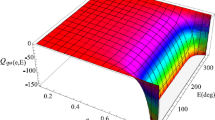Abstract
Will (1971) has discussed a possible anisotropy in the gravitational constantG. Suppose that the attractive gravitational force between two particles of massesm 1 andm 2 is given by the usual expressionF=−Gm 1 m 2 r/r 3, wherer is the separation vector. Ifc is the velocity of light in vacuo and if 1 r ≡r/r, he expresses the anisotropy byG=G ∞[1+ε(v·1 r/c)2], whereG ∞ is a constant,v is identified practically as the velocity of the Sun around the galaxy, and ε≈1. Will's suggestion is to look for such an effect in the laboratory.
The purpose of the present paper is to look for such an effect in the solar system, wherem 1 andm 2 become the masses of the Sun and a planet or of the Earth and the Moon. For simplicity I consider only those planets whose orbits are close to the ecliptic, so that the angle betweenv and the plane of the ecliptic is about 59°.
With the above force, the resulting two-body problem is completely solvable. The results are these. If ε=1, there is an increase in mean motion of 7 parts in 108, a periodic fluctuation in true longitude with period half that of the orbit and amplitude ranging possibly from 0.01″ to 0.02″, and periodic fluctuations in the radius vector, with period also one half that for the orbit. The amplitudes are: 2.7 km for Mercury, 5.1 km for Venus, 7.0 km for Mars, 18 m for the Moon about the Earth, and 28 cm for a close artificial satellite with inclination 23°. The more conservative estimate ε<0.0115 would reduce these values by the factor 70.
Similar content being viewed by others
References
Allen, C. W.: 1962,Astrophysical Quantities, University of London, Athlone Press, p. 268.
de Vaucouleurs, G. and Peters, W. L.: 1970,Trans. Intern. Astron. Un.,Vol.XIV A, Reports on Astronomy 1970, D. Reidel Publishing Co., Dordrecht-Holand, p. 374.
Smart, W. M.: 1953,Celestial Mechanics, Longmans, Green and Co., New York, pp. 31 and 32.
Will, C. M.: 1971,Astrophys. J. 149, 141–155.
Author information
Authors and Affiliations
Rights and permissions
About this article
Cite this article
Vinti, J.P. Possible effects of anisotropy ofG on celestial orbits. Celestial Mechanics 6, 198–207 (1972). https://doi.org/10.1007/BF01227781
Received:
Issue Date:
DOI: https://doi.org/10.1007/BF01227781




